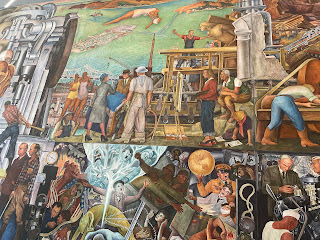 |
| Tepatitlan, the funeral processon |
I decided to make a trek across Los Altos de Jalisco, the highlands between Guadalajara and Guanajuato. A priest I talked to in the town of Canadas de Obregon told me the people of the region, like my grandparents, uncles, and aunts, no matter where they ended up, would maintain close ties to the land of their birth. To make his point, he raised his eyes, and said, “Mi alma va al cielo.” Then he smiled, made a fist, and pumped his heart, “Pero mi corazon esta en Los Altos.”
As the oldest of my siblings, and many of my cousins, I spent much time with my grandmother and older relatives who told me stories of their life in Mitic, a rancho, once an ancient Indian settlement, some 45-minutes outside of Jalostotitlan, the closest major city.
A little closer is the town of San Gaspar de Los Reyes, so small that when I visited there were no hotels or restaurants.
If you ask my relatives, or any of their friends who came north during the Revolution, around 1910, they liked to say they were from San Juan de Los Lagos, a larger, more prestigious city, mainly because pilgrims travelled from all over Mexico to pay their respects to the virgin of San Juan. Sure, we all want to hail from somewhere important, and for the people of Los Altos, San Juan is it.
I’d read that the end of the Chichimeca Wars, between the Spaniards and the natives of the Gran Chichimeca region, most of Jalisco was vast, vacant land. Accordingly, the ruling Spaniards would arrest rebellious Spaniards, or mestizos, essentially criminals, and they’d send them to wander the wilds of Los Altos, figuring, I suppose, if the animals didn’t get them the Indians would. So, it was with this in mind that I made my way by bus, both expresses and locals, to as many towns as I could reach.
I’d visited Jalisco many times but had never been to Tepatitlan, famous for its charros, mariachis, and beautiful women, mythologized in song and dance.
As always, when I travel, I liked to settle in university towns, where I find museums, bookstores, restaurants, music, even lectures. Not so in Los Altos.
I mean, Tepa had a university, which I located after three long bus rides to the outskirts of the city, and a forty-five-minute walk along a country road. When I arrived, I found it closed for summer. The guards wouldn’t let me pass a certain point, so I was only able to see it from afar, and it looked more like a large community college than a university.
That’s when I realized what I’d already suspected, I hailed from the land of rancheros not academics.
My people are of the land. They are hard workers. They work with their hands, sunup to sunset, to make something from nothing. They are tough, weather-beaten, and proud. They don’t want to hear excuses. Maybe I can compare them to Midwesterners in the U.S., farmers and ranchers, the salt of the earth, the way I’d work as a kid and young man, delivering newspapers, construction, gardening, or whatever would bring in a buck.
 |
| The Towers of Tepa |
Here is where I’ll start. From my journal, Tepatitlan, Saturday, August 6, 2016. 11:00 A.M.
The first thing that strikes me this morning as I sit in the Plaza Morelos, one of the two plazas de Armas in the center of Tepa are the church towers. They rise into the sky, like sentinels over the people. They are massive, four towers stacked on each other, topped off by rounded cupolas and crosses.
The smaller plaza where I sit is crowded with old men wearing cowboy hats. Many of the men sit on wrought iron benches. Others stand around. They’re all talking. This is their retirement. They look like they are happy to be meeting every day like this, a ritual, I suppose, or just happy to be alive one more day.
They tell stories and catch up on the news. The old man next to me is talking to another man, describing the death of a friend. They talk about so-and-so from San Juan and how much land he now owns.
The man beside me asks his friend, “Do you remember, Trino, that tall, light-skin guy from El Valle? Well, I think he died.”
“Yeah, I do remember him.”
“I mean, I think he died. He was a pinche.”
“Yeah, that’s him.”
“He played in a baseball game and went sliding into third base. They tagged him out. He was mad. Everyone said he was out. When he complained, somebody said, ‘Well, hide your signals, dude.’ Yes, he was un corajudo. Tepa was the name of his team. Industrias de Tepa sponsored his team. That’s why they named it just Tepa for short.”
Most of these men look older than me, probably in the 70s and 80s, but there are a few standing around who are about my age, maybe younger. I wonder had I been born here, and had my grandparents never migrated to Santa Monica, California, would I be sitting around in a cowboy hat shooting the shit, too?
Another man just walked up, a short man, rugged looking, wearing a baseball cap. One of the men says, “Good morning. What a miracle to see you.”
The man answers, “What do you mean what a miracle? I live here, don’t I?” Then he says, nodding to a group of men, which I’m not sure how to translate, “Mira, esa cabronaza parada alla.” Something like, “Look at those sons of bitches standing over there.”
The thing about the Mexican working-class version of Castellano is that it is peppered with so many obscenities it carries a meaning all its own.
Sunday, August 7
I watch twelve horses, eleven with riders, one riderless, come up the calle Lerdo de Tejada. They turn on Esparza and station themselves alongside the church of St. Francis. A half-hour later, a hearse pulls up and the church yard fills quickly.
I walk across the street and see a procession forming, the men on horses in the middle, one of them guiding the riderless horse. A group of people starts to form on a corner to watch. I say to a man next to me, “He must have been someone important.”
He answers, “A local.”
“Was he a rancher?”
“He lived out of town on one of the ranches, yes.”
“Was he very old?”
“About fifty. We called him, El….”
I don’t understand the word he uses. “What does that mean?”
“It’s a pig on the farm that has gotten too fat. He was short and fat.”
“He must have been pretty popular for all these people to show up.”
“Look,” the man says, pointing. “That’s his horse, the one with no rider.”
“Is that a tradition?”
“For those with horses, but this is nothing. You should have seen when Dr. Gonzalez died. You couldn’t even get through the streets.”
“People liked him?”
“He treated everyone, rich and poor. Even if you couldn’t pay, he’d still treat you. He was a good man. The whole city came out that day.”
“Gonzalez is a pretty common name in Los Altos. My grandfather was a Gonzalez.”
He looks at me and laughs, “We say there are more Gonzalez than burros.”
Happy Thanksgiving












































